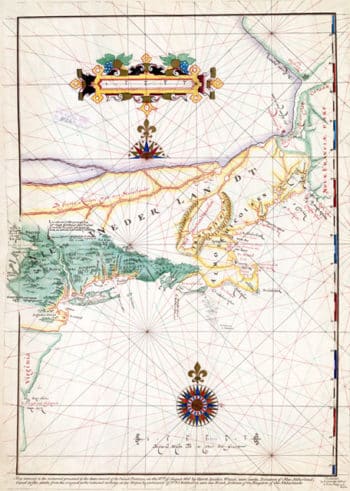Adriaen Block was a private trader and famous explorer for the Dutch Republic who is best known for exploring the coastal and river valley areas between the future New Jersey colony and Massachusetts Bay Colony during four voyages from 1611 to 1614, following the 1609 expedition by Henry Hudson.

He is noted for naming Block Island, Rhode Island, and establishing early trade with the Native Americans of the region, and for the 1614 map of his last voyage on which many features of the mid-Atlantic region appear for the first time, and on which the term New Netherland (now New York) is first applied to the region.
Jump to:
Adriaen Block Facts: Early Years
He is credited with being the first European to enter Long Island Sound and the Connecticut River and to determine that Manhattan and Long Island are islands.
Adriaen Block was born in Amsterdam somewhere around 1567. There is not much known about his childhood, and by 1603, he married Neeltje Hendricks van Gelder. The two of them had five children together, and in 1606, they moved to a house located on Oude Waal Street. The two of them would spend the rest of their lives at this location.
While not much is known about Block's childhood, it is certain that he was active in the shipping trade in the 1590s. He was transporting wood from northern Europe to Spain. This was an excellent job, and during this time, he was able to learn about navigation, sailing, and politics.
In the spring of 1604, Block failed to deliver goods to Cyprus but intercepted a ship heading to Brazil. He captured the ship and its goods and took it to Amsterdam.
This is the event that would change his life and social standing. He made a large amount of money from this capture and would gain a reputation as an excellent privateer, and this led to him purchasing the house on Oude Waal Street.
Adriaen Block Facts: New World Expeditions
Henry Hudson opened up the New World for the Dutch merchants when he made contact with the Native Americans. Merchants from the Dutch Republic began to cultivate trade with the natives for beaver pelts, which was a lucrative market in Europe.
In 1612, Adriaen Block and Hendrick Christiaensen returned from Canada with furs and two sons of the native sachem (or chiefs). This netted Block another large sum of money and proved to the Dutch Republic how profitable the fur trade could be. He would make another two voyages between 1612 - 1613 to Canada to acquire more furs.
In 1613, Block made a fourth voyage to the lower Hudson and was accompanied by many other ships equipped for trading.
While moored along with southern Manhattan, his ship was accidentally destroyed by fire. Over the winter, he and his men, along with some of the natives, built a new ship. He would use this new ship to continue his expedition.
In this later ship, he explored the East River and was the first known European to navigate and enter Long Island Sound.
Travelling along Long Island Sound, he entered the Housatonic River and the Connecticut River, which he explored at least as far as present-day Hartford, sixty miles up the river. Leaving Long Island Sound, he charted Block Island, which is named for him, and Narragansett Bay, where he possibly named "Roode Eylandt" after the red color of its soil.
On Cape Cod, he rendezvoused with one of the other ships of the expedition and returned home.
Adriaen Block Facts: Later Years
Upon returning, Block compiled a map of his voyage together with known information of the time. The Block map was the first to apply the name "New Netherland" to the area between English Virginia and French Canada, as well as the first to show Long Island as an island.

On October 11, 1614, Block, Christiaensen, and a group of twelve other merchants presented to the States-General a petition to receive exclusive trading privileges for the area. Their company, the newly formed New Netherland Company, was granted exclusive rights for three years to trade between the 40th parallel north and the 45th parallel north.
After his return to Amsterdam in July 1614, he would not return to the New World again. In 1615, Block was Commissary-General of three men-of-war and eleven whaleships sent to Spitsbergen by the Noordsche Compagnie.
He remained sailing until his death in 1627. He was buried in Amsterdam's Oude Kerk, a grave next to his wife.
Adriaen Block Facts: Online Resources
- Wikipedia - Adriaen Block
- The Society of Colonial Wars - 1614 Adriaen
- The History Nerd - Holland on the Hudson
- Find a Grave - Adriaen Block
- The History Junkie's Guide to Famous Explorers
- The History Junkie's Guide to Colonial America
- The History Junkie's Guide to Rhode Island Colony
- The History Junkie's Guide to American Revolutionary War
